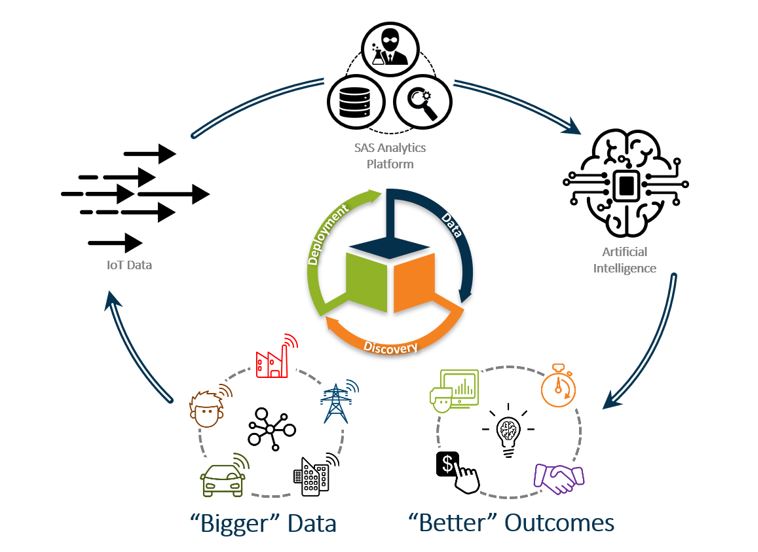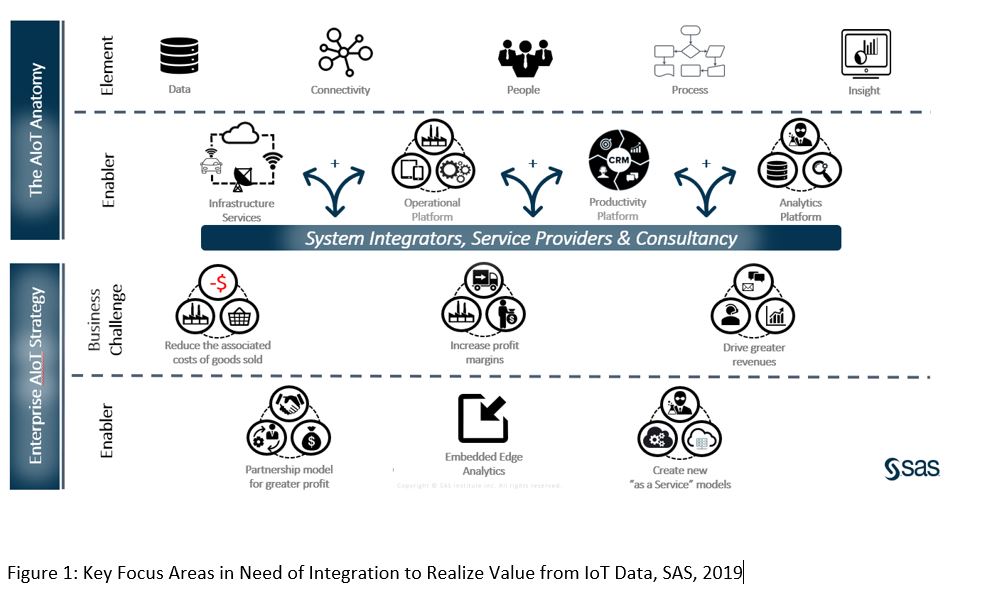

As businesses grow, the need to be competitive, innovative, relevant and agile also grows, therefore the need for deeper insight, faster information, greater collaboration and new commercial ideas become a high priority. This said, trying to analyze this type of diverse IoT data is physically impossible for a human, hence the association and need for Artificial Intelligence (AI) becomes synonymous with IoT. The link between these new challenges is advanced analytics.

With more than 55 billion IoT devices by 2025 – more than four devices for every person on earth - meaning Big Data is only getting bigger. The need to use high frequency, high velocity data for some sort of benefit is the purpose of connecting the physical world with the digital world, but not analyzing this data effectively is a missed opportunity to drive the outcomes your business needs to thrive. To unlock the value of the pervasive nature of IoT data, a strategy is needed, and the ability to digest high volumes of data from multiple sources is required. Taking a platform approach provides a flexible framework to allow a business to extract the value from IoT initiatives to deliver the outcomes business are looking for.
As certain buzz words gain more momentum, the Chief Analytical Officer (CAO) gains more credibility in the work place. As covered in a recent McKinsey study, this role has morphed into the catalyst for business change and driver for greater efficiencies. But behind the hype, how can the CAO and Chief Technology Officer (CTO), who drive the innovation strategy, conspire to do this? The first battle must be the common understanding of the language used in analytics, one person’s AI is another person’s ‘black magic’ when reviewing technology; should you buy or build? Best-in-class or single vendor strategy? Decisions, decisions…
Strategic decisions and answers to these questions are very subjective and relative to the business issue being addressed, but when you look deeper into the required ecosystems that define an IoT strategy, analytics highlights the question around how the CAO and CTO interlink with all these other partners and capabilities to support this complimentary strategy.
As McKinsey wrote, the key roles for CAOs need to focus on:
Ref: McKinsey – Rebooting analytics leadership: Time to move beyond the math

Integrating these key focus areas into IoT projects is critical to surface the hidden value in IoT data. In figure 1, I have simplified what I believe to be the key elements in an IoT capability covering; data, connectivity, people, process and insight. Therefore, the CAO provides the skills and knowledge of how to unlock this value of integrating, visualizing and transforming diverse and voluminous IoT data from different processes sources by applying advanced analytics, AI and capabilities to share the insights and democratize analytics via their platforms. This goes beyond the simple analytics, statistical models, and business rules that most ‘IoT platforms’ boast today.
Do not be hypnotized by vendors that simply state the buzz words as a proven capability; businesses need to ask the difficult questions:
The questions I raise are not designed to isolate vendors’ limitations, but to highlight the facts that taxonomy and standards are so subjective in our industries right now; meaning a school child can start a business in his bedroom and state to be an AI expert with a pretty logo and get credibility quite quickly. The best analogy can be compared with self-diagnosis that we are all guilty of versa a visit to the doctor; if you think you have the plague a quick google search can provide quick validation, but if your concerns are quite genuine (and Google says you have the plague) a swift trip to the doctor is made. Why? Because they trained for years in being competent in what they do. We trust experience.
This is true for analytics platforms, most technology-savvy enthusiasts can validate a hypothesis around analytics quite quickly with open source and maybe a smart algorithm. But ask the question; what makes this the right technology to entrust serious business decisions and serious commercial implications? You need reassurance that these capabilities have pedigree, years of investment and development, and have led to processes and techniques that deliver the value you seek.
So where am I going with this? As the term AI grows ever more important so does the questions around how much we should trust the outputs of AI --ranging from autonomous cars to manufacturing automation to personalised chatbots guiding you through a shopping experience. AI is ‘here & now’. It looks to become a common term around how we can understand digital interaction, but we need to ask a few questions over and above blind faith. The IoT is the connection of digital to physical and the association of AI to manage the amount of data being generated from these capabilities is also becoming synonymous with IoT, becoming known as the Artificial Intelligence of Things (AIoT). There is a clear importance of including the CAOs, CTOs and others who understand the complexities of advanced analytics in conversations within any early phases around new business initiatives. AIoT can turn IoT data into new revenue streams, exciting business models, optimized operational environments and differentiated customer experiences.
My advice: do not be intimidated by the hype, ask deep and relevant questions and think big. The opportunities are there, you just need to put some efforts into finding them and understanding what is being presented to you.
Further information regarding artificial Intelligence, IoT, advanced analytics and digital transformation can also be found on the ARC Advisory Group website.
About the author
Tim helps customers in the manufacturing sector achieve better operational and business outcomes by applying SAS Analytics for IoT, an industry-leading integrated software solution including AI, advanced analytics, business intelligence, data management, and predictive analytics.

